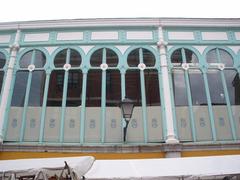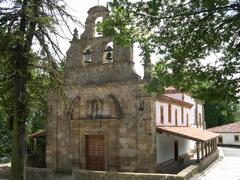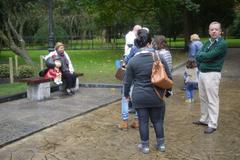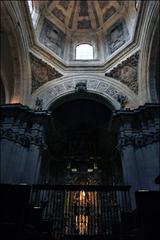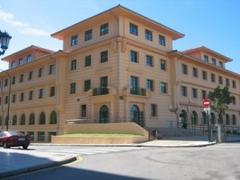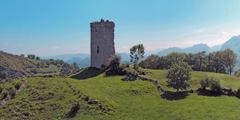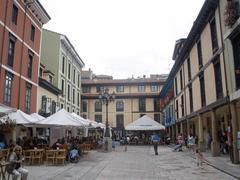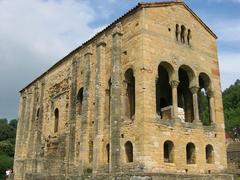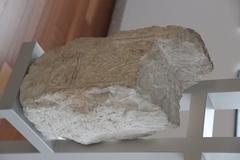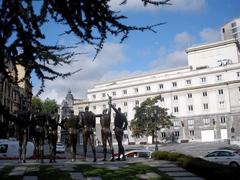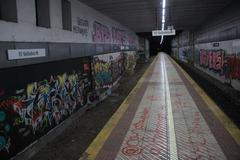
ऐडा लाफुएंट पेनोस, ओवiedo शहर, स्पेन की यात्रा के लिए व्यापक गाइड: इतिहास, महत्व, आगंतुक सुझाव, और पर्यटकों को यादगार अनुभव के लिए सब कुछ जानना होगा
दिनांक: 04/07/2025
परिचय
ओवiedo में ऐडा लाफुएंट स्मारक, एक युवा कार्यकर्ता को एक शक्तिशाली श्रद्धांजलि के रूप में खड़ा है, जिनके साहस और राजनीतिक प्रतिबद्धता ने 1934 के अस्टूरियन विद्रोह के दौरान अस्टुरियास और स्पेन के इतिहास पर एक अमिट छाप छोड़ी। ऐडा डी ला फुएंट पेनोस, जिन्हें ऐडा लाफुएंट के नाम से जाना जाता है, को न केवल 19 साल की उम्र में उनके व्यक्तिगत बलिदान के लिए याद किया जाता है, बल्कि 20वीं सदी की शुरुआत के स्पेन के व्यापक सामाजिक और राजनीतिक संघर्षों के भीतर युवा, नारीवाद और प्रतिरोध के प्रतीक के रूप में भी याद किया जाता है। यह व्यापक मार्गदर्शिका उसके स्मारक के ऐतिहासिक संदर्भ और महत्व की पड़ताल करती है, अप-टू-डेट आगंतुक जानकारी प्रदान करती है, और ओवiedo की समृद्ध ऐतिहासिक और सांस्कृतिक विरासत से जुड़ने के तरीके सुझाती है (किड्डे: ऐडा लाफुएंट; विकिपीडिया: ऐडा लाफुएंट; ओवiedo मूर्तिकला गाइड).
विषय सूची
- प्रारंभिक जीवन और पारिवारिक पृष्ठभूमि
- 20वीं सदी की शुरुआत में स्पेन में राजनीतिक माहौल
- ऐडा लाफुएंट की सक्रियता और 1934 का अस्टूरियन विद्रोह
- ऐडा लाफुएंट स्मारक: इतिहास, डिजाइन, और प्रतीकवाद
- आगंतुक जानकारी: घंटे, पहुंच, और यात्राएं
- निकटवर्ती ओवiedo आकर्षण
- सांस्कृतिक प्रभाव और स्मरण
- अक्सर पूछे जाने वाले प्रश्न (FAQ)
- सारांश और आगंतुक सुझाव
- संदर्भ
प्रारंभिक जीवन और पारिवारिक पृष्ठभूमि
ऐडा डी ला फुएंट पेनोस का जन्म 25 फरवरी, 1915 को स्पेन के लियोन में हुआ था, एक ऐसे परिवार में जो कलात्मक और राजनीतिक दोनों क्षेत्रों में गहराई से जुड़ा हुआ था। उनके पिता, गुस्तावो डी ला फुएंट, ओवiedo में कैम्पोअमोर थिएटर के लिए एक चित्रकार के रूप में काम करते थे और शहर में स्पेनिश कम्युनिस्ट पार्टी के संस्थापक सदस्य थे। सामाजिक न्याय और राजनीतिक सक्रियता के लिए परिवार की प्रतिबद्धता ने ऐडा के पालन-पोषण को गहराई से प्रभावित किया, जिससे उन्हें अपनी मां, जीसुसा पेनोस, और अपने भाई-बहनों के साथ वामपंथी कारणों में उनकी शुरुआती भागीदारी को बढ़ावा मिला (किड्डे: ऐडा लाफुएंट).
20वीं सदी की शुरुआत में स्पेन में राजनीतिक माहौल
20वीं सदी की शुरुआत स्पेन में तीव्र उथल-पुथल का काल था, जो रूढ़िवादी और प्रगतिशील ताकतों के बीच गहरे विभाजन से चिह्नित था। 1931 में द्वितीय स्पेनिश गणराज्य की स्थापना ने सुधार लाए लेकिन सामाजिक और राजनीतिक संघर्ष को भी तेज कर दिया। अस्टुरियास, अपनी खानों और मजबूत श्रमिक आंदोलनों की एकाग्रता के साथ, समाजवादी और कम्युनिस्ट सक्रियता का केंद्र बन गया, जिसने 1934 के विद्रोह के लिए आधार तैयार किया (किड्डे: ऐडा लाफुएंट).
ऐडा लाफुएंट की सक्रियता और 1934 का अस्टूरियन विद्रोह
स्पेन की कम्युनिस्ट यूथ (Juventudes Comunistas de España) की एक प्रतिबद्ध सदस्य के रूप में, ऐडा लाफुएंट ने बैठकों का आयोजन किया, साहित्य वितरित किया, और श्रमिकों के अधिकारों की वकालत की। उनकी सक्रियता एक व्यापक युवा आंदोलन का हिस्सा थी जिसने अस्टुरियास के औद्योगिक समुदायों को लामबंद करने में महत्वपूर्ण भूमिका निभाई।
अक्टूबर 1934 में, अस्टूरियन विद्रोह हुआ जब खनिकों और श्रमिकों ने रूढ़िवादी सरकार की नीतियों के खिलाफ विद्रोह किया। प्रतिक्रिया एक क्रूर सैन्य कार्रवाई थी, जिसके परिणामस्वरूप हजारों हताहत हुए। 13 अक्टूबर, 1934 को, ऐडा की ओवiedo में मृत्यु हो गई, और वह सामाजिक न्याय के कारण की शहीद बन गई (किड्डे: ऐडा लाफुएंट; विकिपीडिया: ऐडा लाफुएंट).
ऐडा लाफुएंट स्मारक: इतिहास, डिजाइन, और प्रतीकवाद
स्थान और निर्माण
ऐडा लाफुएंट स्मारक, ओवiedo के पश्चिमी किनारे पर सैन पेड्रो डी लॉस आर्कस पार्क में स्थित है - एक ऐसा स्थान जहां विद्रोह के दौरान उनकी मृत्यु हुई थी। पार्क के मुख्य एवेन्यू का नाम 1995 में ओवiedo सिटी काउंसिल द्वारा पासेओ डी ऐडा लाफुएंट रखा गया था (ओवiedo मूर्तिकला गाइड). फेलिक्स अलोंसो एरेना द्वारा बनाई गई और 1997 में सार्वजनिक सदस्यता के माध्यम से स्थापित इस स्मारक में अस्टुरियास के कांस्य मानचित्र और ऐडा की छवि वाले एक मेडलियन के साथ एक पत्थर का मोनोलिथ है, जिस पर “रेवोल्यूशन डे ओक्टुब्रे डे 1934” लिखा हुआ है।
प्रतीकवाद
यह स्मारक ऐडा को एक व्यक्ति के रूप में और अस्टुरियास में सामाजिक न्याय के व्यापक संघर्ष दोनों का सम्मान करता है। अस्टुरियास के “रोज़ा रोजा” (लाल गुलाब) के रूप में जानी जाने वाली ऐडा की छवि स्पेनिश गृहयुद्ध के दौरान रिपब्लिकन प्रतीकवाद का केंद्र बन गई, जिससे प्रतिरोध और युवा सक्रियता के प्रतीक के रूप में उनकी स्थिति और मजबूत हुई (विकिपीडिया: ऐडा लाफुएंट).
आगंतुक जानकारी: घंटे, पहुंच, और यात्राएं
यात्रा के घंटे और टिकट
- खुली पहुंच: स्मारक एक सार्वजनिक पार्क में है और साल भर, 24 घंटे उपलब्ध है। प्रवेश शुल्क या टिकट की कोई आवश्यकता नहीं है।
पहुंच
- व्हीलचेयर पहुंच: पार्क और स्मारक क्षेत्र व्हीलचेयर सुलभ हैं, जिनमें पक्की सड़कें और आस-पास की सुविधाएं हैं।
निर्देशित यात्राएं और कार्यक्रम
- निर्देशित यात्राएं: स्मारक के लिए कोई समर्पित निर्देशित यात्राएं नहीं हैं, लेकिन यह ओवiedo की कुछ व्यापक ऐतिहासिक और सांस्कृतिक यात्राओं में शामिल है। स्थानीय पर्यटन कार्यालय और ऑडिएला ऐप उपलब्ध यात्राओं के बारे में अद्यतित जानकारी प्रदान कर सकते हैं।
- स्मृति कार्यक्रम: अक्टूबर में वार्षिक समारोह आयोजित किए जाते हैं, विशेष रूप से अस्टूरियन क्रांति की वर्षगांठ के आसपास, जिसमें पुष्पांजलि अर्पित की जाती है और शैक्षिक गतिविधियां आयोजित की जाती हैं (विज़िट साइट्स: ओवiedo टूर).
निकटवर्ती ओवiedo आकर्षण
- कैम्पोअमोर थिएटर: जहां ऐडा के पिता काम करते थे और ओवiedo के सांस्कृतिक इतिहास का एक मील का पत्थर।
- कैथेड्रल ऑफ़ सैन साल्वाडोर: पुराने शहर में एक यूनेस्को-सूचीबद्ध गोथिक कैथेड्रल।
- कैम्पो डे सैन फ्रांसिस्को: ओवiedo का सबसे बड़ा पार्क, सार्वजनिक कला और हरे-भरे स्थानों से भरा हुआ।
- एल फोंटन मार्केट: एक हलचल भरा स्थानीय बाजार, अस्टूरियन व्यंजन और संस्कृति का स्वाद लेने के लिए एकदम सही।
- नारानको पर्वत पर पूर्व-रोमनस्क चर्च: यूनेस्को विश्व धरोहर स्थल जो शहर से आसानी से सुलभ हैं (goaskalocal.com; broganabroad.com).
सांस्कृतिक प्रभाव और स्मरण
ऐडा लाफुएंट की कहानी न केवल स्मरणोत्सव और शैक्षिक पहलों को प्रेरित करती है, बल्कि साहित्य, संगीत और दृश्य कला में कलात्मक अभिव्यक्तियों को भी प्रेरित करती है। प्रतिरोध और महिला सशक्तिकरण के प्रतीक के रूप में उनकी विरासत ओवiedo के शहरी परिदृश्य में दिखाई देती है - स्मारकों, सड़क के नामों और सार्वजनिक स्मृति के प्रति शहर की प्रतिबद्धता के माध्यम से (ओवiedo मूर्तिकला गाइड).
अक्सर पूछे जाने वाले प्रश्न (FAQ)
प्रश्न: ऐडा लाफुएंट स्मारक के यात्रा घंटे क्या हैं? ए: स्मारक एक सार्वजनिक पार्क में स्थित होने के कारण 24/7 सुलभ है।
प्रश्न: क्या कोई प्रवेश शुल्क है या टिकट की आवश्यकता है? ए: नहीं, स्मारक का दौरा करना निःशुल्क है।
प्रश्न: क्या निर्देशित यात्राएं उपलब्ध हैं? ए: ओवiedo की कुछ सामान्य ऐतिहासिक यात्राओं में स्मारक एक पड़ाव के रूप में शामिल है। विवरण के लिए स्थानीय पर्यटन कार्यालयों या ऑडिएला ऐप से संपर्क करें (विज़िट साइट्स: ओवiedo टूर).
प्रश्न: क्या स्मारक व्हीलचेयर सुलभ है? ए: हां, पार्क और स्मारक क्षेत्र में व्हीलचेयर उपयोगकर्ताओं के लिए उपयुक्त पक्की सड़कें हैं।
प्रश्न: क्या स्मारक पर कोई विशेष कार्यक्रम होते हैं? ए: अस्टूरियन क्रांति की वर्षगांठ को चिह्नित करने के लिए अक्टूबर में वार्षिक स्मृति कार्यक्रम होते हैं।
सारांश और आगंतुक सुझाव
ऐडा लाफुएंट स्मारक ओवiedo का एक महत्वपूर्ण ऐतिहासिक स्थल है, जो शहर के क्रांतिकारी अतीत और युवा सक्रियता और सामाजिक न्याय के स्थायी मूल्यों से एक सार्थक जुड़ाव प्रदान करता है। इसकी खुली पहुंच, केंद्रीय स्थान और अन्य सांस्कृतिक स्थलों से निकटता के साथ, यह स्पेन के इतिहास में रुचि रखने वाले आगंतुकों के लिए एक आवश्यक पड़ाव है।
आगंतुक सुझाव:
- सर्वोत्तम दृश्यों और तस्वीरों के लिए दिन के उजाले में जाएँ।
- एक व्यापक सांस्कृतिक अनुभव के लिए ओवiedo के अन्य स्थलों के साथ अपनी यात्रा को मिलाएं।
- निर्देशित यात्राओं और वास्तविक समय अपडेट के लिए ऑडिएला ऐप डाउनलोड करें।
- साइट का सम्मान करें, विशेष रूप से स्मृति कार्यक्रमों के दौरान।
स्मारक और ओवiedo के व्यापक ऐतिहासिक परिदृश्य से जुड़कर, आगंतुक क्षेत्र की जटिल पहचान और ऐडा लाफुएंट जैसे आंकड़ों की शक्तिशाली विरासत की गहरी समझ प्राप्त करते हैं।
संदर्भ और आगे पढ़ना
- किड्डे: ऐडा लाफुएंट
- विकिपीडिया: ऐडा लाफुएंट
- ओवiedo मूर्तिकला गाइड
- विज़िट साइट्स: ओवiedo टूर
- Go Ask a Local: ओवiedo गाइड
- Brogan Abroad: ओवiedo में करने योग्य चीज़ें
ऑडिएला2024{‘date’: ‘04/07/2025’, ‘task’: {‘model’: ‘gpt-4.1-mini’, ‘query’: ‘Comprehensive guide to visiting Aida Lafuente Penaos, Oviedo City, Spain: history, significance, visitor tips, and everything tourists need to know for a memorable experience.’, ‘verbose’: False, ‘guidelines’: [“Keyword Research: Identify relevant keywords that potential visitors are likely to search for, such as ‘[Monument Name] visiting hours,’ ‘[Monument Name] tickets,’ and ‘[City] historical sites.’ Use these keywords strategically throughout the article, including in the title, headers, and body text, but avoid keyword stuffing.”, ‘Engaging and Informative Title: Craft a title that is both SEO-friendly and compelling to encourage clicks. Include the main keyword and make it clear what the article will cover.’, ‘Structured Content: Use headings (H1, H2, H3) to organize the content effectively. This helps with SEO and makes the article easier for readers to navigate. Include an introduction that hooks the reader, a detailed body that covers all relevant aspects, and a conclusion that summarizes the key points.’, ‘Comprehensive Coverage: Address common questions and topics of interest such as the history of the monument, its cultural significance, visitor information (e.g., ticket prices, opening hours), travel tips, nearby attractions, and accessibility. Include sections that might be unique to the monument, like special events, guided tours, and photographic spots.’, ‘Quality Content: Ensure the content is well-researched, accurate, and provides real value to readers. Use reliable sources and provide factual information. Write in a clear, engaging, and accessible style. Consider your audience and use language that is appropriate for those likely to visit the monument.’, ‘Visuals and Media: Incorporate high-quality images or videos of the monument. These should be optimized for the web (correct sizing, alt tags with keywords). Consider interactive elements like virtual tours or maps.’, ‘Internal and External Links: Include links to other related articles on your site to encourage deeper engagement (internal links). Link to official websites for the monument or credible sources for further reading (external links).’, ‘FAQ: Incorporate FAQ sections to target voice search queries and featured snippets’, ‘Visit and Stay Up to Date: End the article with a call to action, such as encouraging readers to download our mobile app Audiala, check out other related posts, or follow on social media for more updates.’], ‘max_sections’: 4, ‘publish_formats’: {‘pdf’: False, ‘docx’: False, ‘markdown’: True}, ‘follow_guidelines’: True}, ‘title’: ‘Comprehensive Guide to Visiting Aida Lafuente Penaos in Oviedo City, Spain’, ‘report’: ’# Aida Lafuente Penaos Visiting Hours, Tickets, and Oviedo Historical Sites Guide\n#### Date: 04/07/2025\n\n## Introduction\n\nThe Aida Lafuente monument in Oviedo stands as a powerful tribute to a young activist whose bravery and political commitment during the Asturian Uprising of 1934 left an indelible mark on Asturias’ and Spain’s history. Aida de la Fuente Penaos, known as Aida Lafuente, is remembered not only for her personal sacrifice at the age of 19 but also as a symbol of youth, feminism, and resistance within the broader social and political struggles of early 20th-century Spain. This comprehensive guide explores the historical context and significance of her memorial, provides up-to-date visitor information, and suggests ways to connect with Oviedo’s rich historical and cultural heritage (Kiddle: Aida Lafuente; Wikipedia: Aida Lafuente; Oviedo Sculpture Guide).\n\n---\n\n## Table of Contents\n- Early Life and Family Background\n- Political Climate in Early 20th Century Spain\n- Aida Lafuente’s Activism and the 1934 Asturias Uprising\n- The Aida Lafuente Monument: History, Design, and Symbolism\n- Visitor Information: Hours, Accessibility, and Tours\n- Nearby Oviedo Attractions\n- Cultural Impact and Memorialization\n- Frequently Asked Questions (FAQ)\n- Summary and Visitor Tips\n- References\n\n---\n\n## Early Life and Family Background\n\nAida de la Fuente Penaos was born on February 25, 1915, in León, Spain, into a family deeply engaged in both artistic and political spheres. Her father, Gustavo de la Fuente, worked as a painter for the Campoamor Theater in Oviedo and was a founding member of the Communist Party of Spain in the city. The family’s commitment to social justice and political activism profoundly influenced Aida’s upbringing, fostering her early involvement in leftist causes alongside her mother, Jesusa Penaos, and her siblings (Kiddle: Aida Lafuente).\n\n---\n\n## Political Climate in Early 20th Century Spain\n\nThe early 20th century was a period of intense upheaval in Spain, marked by deep divisions between conservative and progressive forces. The establishment of the Second Spanish Republic in 1931 brought reforms but also intensified social and political conflict. Asturias, with its concentration of miners and strong labor movements, became a focal point for socialist and communist activism, laying the groundwork for the 1934 uprising (Kiddle: Aida Lafuente).\n\n---\n\n## Aida Lafuente’s Activism and the 1934 Asturias Uprising\n\nAs a committed member of the Communist Youth of Spain (Juventudes Comunistas de España), Aida Lafuente organized meetings, distributed literature, and advocated for workers’ rights. Her activism was part of a broader youth movement that played a significant role in mobilizing Asturias’ industrial communities.\n\nIn October 1934, the Asturias Uprising erupted as miners and workers revolted against the conservative government’s policies. The response was a harsh military crackdown, resulting in thousands of casualties. On October 13, 1934, Aida was killed in Oviedo, becoming a martyr for the cause of social justice (Kiddle: Aida Lafuente; Wikipedia: Aida Lafuente).\n\n---\n\n## The Aida Lafuente Monument: History, Design, and Symbolism\n\n### Location and Creation\n\nThe Monument to Aida Lafuente stands in Parque de San Pedro de los Arcos, on Oviedo’s western edge—a site near where she lost her life during the uprising. The park’s main avenue was renamed Paseo de Aida Lafuente in 1995 by the Oviedo City Council (Oviedo Sculpture Guide). The monument, created by Félix Alonso Arena and installed in 1997 through public subscription, features a stone monolith with a bronze map of Asturias and a medallion bearing Aida’s likeness, inscribed with “Revolución de Octubre de 1934.”\n\n### Symbolism\n\nThe memorial honors both Aida as an individual and the broader struggle for social justice in Asturias. Known as the “Rosa Roja” (Red Rose) of Asturias, Aida’s image became central to Republican iconography during the Spanish Civil War, further cementing her status as a symbol of resistance and youth activism (Wikipedia: Aida Lafuente).\n\n---\n\n## Visitor Information: Hours, Accessibility, and Tours\n\n### Visiting Hours and Tickets\n\n- Open Access: The monument is in a public park and is accessible year-round, 24 hours a day. There are no entrance fees or tickets required.\n\n### Accessibility\n\n- Wheelchair Access: The park and monument area are wheelchair accessible, with paved paths and nearby amenities.\n\n### Guided Tours and Events\n\n- Guided Tours: While there are no dedicated guided tours for the monument itself, it is included in some broader historical and cultural tours of Oviedo. Local tourism offices and the Audiala app can provide up-to-date information on available tours.\n- Commemorative Events: Annual ceremonies take place in October, particularly around the anniversary of the Asturian Revolution, featuring wreath-laying and educational activities (Visit Sights: Oviedo Tour).\n\n---\n\n## Nearby Oviedo Attractions\n\n- Campoamor Theater: Where Aida’s father worked and a landmark of Oviedo’s cultural history.\n- Cathedral of San Salvador: A UNESCO-listed Gothic cathedral in the old town.\n- Campo de San Francisco: Oviedo’s largest park, filled with public art and green spaces.\n- El Fontán Market: A bustling local market, perfect for sampling Asturian cuisine and culture.\n- Pre-Romanesque Churches on Mount Naranco: UNESCO World Heritage sites easily accessible from the city (goaskalocal.com; broganabroad.com).\n\n---\n\n## Cultural Impact and Memorialization\n\nAida Lafuente’s story continues to inspire not only commemorations and educational initiatives but also artistic expressions in literature, music, and visual art. Her legacy as a figure of resistance and female empowerment is visible in Oviedo’s urban landscape—through monuments, street names, and the city’s commitment to public memory (Oviedo Sculpture Guide).\n\n---\n\n## Frequently Asked Questions (FAQ)\n\nQ: What are the visiting hours of the Aida Lafuente monument? \nA: The monument is accessible 24/7 as it is located in a public park.\n\nQ: Is there an entrance fee or are tickets required? \nA: No, the monument is free to visit.\n\nQ: Are guided tours available? \nA: Some general historical tours of Oviedo include the monument as a stop. Check with local tourism offices or the Audiala app for details (Visit Sights: Oviedo Tour).\n\nQ: Is the monument wheelchair accessible? \nA: Yes, the park and monument area have paved paths suitable for wheelchair users.\n\nQ: Are there special events at the monument? \nA: Commemorative events occur annually in October to mark the anniversary of the Asturian Revolution.\n\n---\n\n## Summary and Visitor Tips\n\nThe Aida Lafuente monument in Oviedo embodies much more than a mere historical marker; it is a vibrant symbol of youthful courage, political resistance, and the enduring fight for social justice in Asturias and Spain at large. As a freely accessible outdoor monument located in a historically significant park and city center, it invites visitors to reflect on the sacrifices made during the Asturias Uprising of 1934 and the broader struggles that shaped modern Spanish society.\n\nAida Lafuente’s legacy as a young communist activist who gave her life for workers’ rights continues to inspire commemorations, educational initiatives, and artistic expressions throughout the region. The monument’s integration into Oviedo’s rich tapestry of public art and its proximity to other cultural and historical landmarks enhance the visitor experience, offering a comprehensive glimpse into the city’s complex political and social history.\n\nFor travelers and history enthusiasts alike, the monument serves as a gateway to exploring Asturias’ revolutionary past, with numerous guided tours and special events available to deepen understanding. Its accessibility, no admission fees, and location within a pedestrian-friendly urban environment make it an ideal destination for a meaningful cultural excursion.\n\nTo make the most of your visit, consider utilizing resources such as the Audiala app for guided tours and up-to-date visitor information, and connect with local tourism offices for event schedules. By engaging with the Aida Lafuente monument and the surrounding historical sites, visitors gain invaluable insights into the spirit of resistance and the role of youth activism in shaping regional and national identity (Visit Sights: Oviedo Tour; Oviedo Sculpture Guide).\n\nEmbark on this journey through Oviedo’s revolutionary heritage and witness firsthand how the memory of Aida Lafuente continues to resonate, inspiring new generations and preserving the legacy of a remarkable figure in Spain’s history.\n\n---\n\n## References and Further Reading\n\n- Kiddle: Aida Lafuente\n- Wikipedia: Aida Lafuente\n- Oviedo Sculpture Guide\n- Visit Sights: Oviedo Tour\n- Go Ask a Local: Oviedo Guide\n- Brogan Abroad: Things to Do in Oviedo\n\n---\n\n’, ‘headers’: {‘date’: ‘Date’, ‘title’: ‘Aida Lafuente Penaos Visiting Hours Tickets and Oviedo Historical Sites Guide’, ‘conclusion’: ‘Summary and Final Tips for Visiting Aida Lafuente Penaos’, ‘references’: ‘References and Further Reading’, ‘introduction’: ‘Introduction to Aida Lafuente Penaos in Oviedo’, ‘table_of_contents’: ‘Table of Contents’}, ‘sources’: [’- Kiddle: Aida Lafuente, 2024, Kids Encyclopedia https://kids.kiddle.co/Aida_Lafuente’, ’- Wikipedia: Aida Lafuente, 2024, Wikipedia https://en.wikipedia.org/wiki/Aida_Lafuente’, ’- Oviedo Sculpture Guide: Monumento a Aida de la Fuente, 2024, Oviedo Vivir Asturias https://oviedo.vivirasturias.com/esculturas/i/60891145/escultura-aida-la-fuente’, ’- Visit Sights: Oviedo Tour, 2024, Visit Sights https://visitsights.com/sightseeing-tours/Spain/Oviedo/5’], ‘sections’: [‘Historical Background’, ‘The Legacy of Aida Lafuente’, ‘Visiting the Aida Lafuente Memorial’, ‘Contextualizing the Memorial: Oviedo’s Historical and Cultural Landscape’], ‘conclusion’: ‘The Aida Lafuente monument in Oviedo embodies much more than a mere historical marker; it is a vibrant symbol of youthful courage, political resistance, and the enduring fight for social justice in Asturias and Spain at large. As a freely accessible outdoor monument located in a historically significant park and city center, it invites visitors to reflect on the sacrifices made during the Asturias Uprising of 1934 and the broader struggles that shaped modern Spanish society.\n\nAida Lafuente’s legacy as a young communist activist who gave her life for workers’ rights continues to inspire commemorations, educational initiatives, and artistic expressions throughout the region. The monument’s integration into Oviedo’s rich tapestry of public art and its proximity to other cultural and historical landmarks enhance the visitor experience, offering a comprehensive glimpse into the city’s complex political and social history.\n\nFor travelers and history enthusiasts alike, the monument serves as a gateway to exploring Asturias’ revolutionary past, with numerous guided tours and special events available to deepen understanding. Its accessibility, no admission fees, and location within a pedestrian-friendly urban environment make it an ideal destination for a meaningful cultural excursion.\n\nTo make the most of your visit, consider utilizing resources such as the Audiala app for guided tours and up-to-date visitor information, and connect with local tourism offices for event schedules. By engaging with the Aida Lafuente monument and the surrounding historical sites, visitors gain invaluable insights into the spirit of resistance and the role of youth activism in shaping regional and national identity (Visit Sights: Oviedo Tour; Oviedo Sculpture Guide).\n\nEmbark on this journey through Oviedo’s revolutionary heritage and witness firsthand how the memory of Aida Lafuente continues to resonate, inspiring new generations and preserving the legacy of a remarkable figure in Spain’s history.’, ‘introduction’: ‘Nestled in the vibrant city of Oviedo, Spain, the Aida Lafuente monument stands as a poignant tribute to a young woman whose courage and activism left an indelible mark on Asturias’ turbulent history. Aida de la Fuente Penaos, known widely as Aida Lafuente, was a committed communist youth activist who tragically lost her life at just 19 during the Asturias Uprising of October 1934. This uprising was a defining moment in Spain’s Second Republic, reflecting the fierce political and social struggles of the time. The monument not only commemorates her personal sacrifice but also symbolizes the broader fight for workers’ rights, social justice, and political resistance that characterized early 20th-century Asturias.\n\nLocated in prominent public spaces like Parque de San Pedro de los Arcos and near key historical landmarks such as the Church of San Pedro de los Arcos and Oviedo Railway Station, the Aida Lafuente monument is accessible year-round without any entrance fees, inviting visitors to engage freely with this significant piece of Oviedo’s historical landscape. Beyond its role as a memorial, the site serves as a cultural touchstone that highlights Aida’s legacy as a feminist icon and revolutionary figure who continues to inspire activism and art.\n\nVisitors to the monument can benefit from a variety of guided tours offered by local operators, enhancing their understanding of the political climate of 1930s Spain and the enduring impact of the Asturias Uprising. The monument’s accessibility, including wheelchair-friendly paths and its location within Oviedo’s pedestrian-friendly city center, makes it an inviting destination for all travelers. Nearby attractions such as the Campoamor Theater, Oviedo Cathedral, and the historic neighborhoods central to the 1934 uprising offer enriching experiences that complement a visit to the monument.\n\nThis comprehensive guide aims to provide practical visitor information—including visiting hours, accessibility, special events, and travel tips—while also delving into the historical significance and cultural impact of Aida Lafuente’s life and memorial. Whether you are a history enthusiast, cultural traveler, or local visitor, exploring the Aida Lafuente monument offers a meaningful connection to Spain’s complex past and the enduring spirit of resistance that defines Asturias (Kiddle: Aida Lafuente; Wikipedia: Aida Lafuente; Oviedo Sculpture Guide).’, ‘research_data’: [{‘draft title’: ‘Aida Lafuente Monument in Oviedo: History, Visiting Hours, and Tourist Guide\n\n## Introduction\n\nThe Aida Lafuente monument in Oviedo stands as a powerful tribute to one of Asturias’ most iconic figures—a young communist activist who became a symbol of resistance during the Asturias Uprising of 1934. This article explores Aida Lafuente’s life, the historical significance of the monument, and practical visitor information including visiting hours, accessibility, and nearby attractions. Whether you are a history enthusiast or a tourist planning your trip to Oviedo, this guide will help you appreciate the legacy of Aida Lafuente and make the most of your visit to this important Oviedo historical site.\n\n## Early Life and Family Background\n\nAida de la Fuente Penaos, widely known as Aida Lafuente, was born on February 25, 1915, in León, Spain. Raised in a politically and artistically active family, her father Gustavo de la Fuente was a painter known for theatrical posters and sets at the Campoamor Theater in Oviedo, Asturias. He was also a founding member of the Communist Party of Spain in Oviedo, deeply influencing Aida’s early political views. Her mother, Jesusa Penaos, and siblings were also engaged in leftist activism, making political engagement a core part of her upbringing (Kiddle: Aida Lafuente).\n\n## Political Climate in Early 20th Century Spain\n\nSpain’s early 20th century was turbulent, marked by political polarization, social unrest, and economic hardship. The establishment of the Second Spanish Republic in 1931 introduced reforms but also deepened divides between conservatives and progressives. Asturias, with its strong mining industry and labor unions, became a hotbed for socialist and communist activism, setting the stage for significant uprisings (Kiddle: Aida Lafuente).\n\n## Aida Lafuente’s Involvement in the Communist Youth of Spain\n\nAida actively joined the Communist Youth of Spain (Juventudes Comunistas de España), organizing meetings, distributing literature, and campaigning for workers’ rights alongside her brothers. This youth organization was instrumental in mobilizing young people in industrial regions like Asturias, where economic inequality fueled political activism (Kiddle: Aida Lafuente).\n\n## The Asturias Uprising of 1934 and Aida Lafuente’s Martyrdom\n\nIn October 1934, a workers’ revolt erupted in Asturias against the conservative government, with miners and workers seizing control of towns and factories. The government’s military crackdown was brutal, resulting in thousands of casualties. At 19, Aida Lafuente was killed in Oviedo during the uprising’s suppression on October 13, 1934. Her death symbolized the sacrifices of youth and workers in their fight for social justice (Kiddle: Aida Lafuente).\n\n## The Aida Lafuente Monument in Oviedo\n\nLocated in the heart of Oviedo, the Aida Lafuente monument honors her legacy as a symbol of courage and resistance. The monument is a significant Oviedo historical site, attracting visitors interested in Spain’s labor movement and political history.\n\n### Visiting Hours and Accessibility\n\n- Visiting Hours: The monument is accessible to the public 24/7 as it is an open-air site in a public square.\n- Entrance Fee: There is no entrance fee to visit the monument.\n- Accessibility: The site is wheelchair accessible, with paved paths leading to the monument.\n\n### Guided Tours and Special Events\n\nGuided walking tours of Oviedo’s historical sites, including the Aida Lafuente monument, are available through local tour operators. Special commemorative events are held annually in October to mark the Asturias Uprising and honor Aida’s memory.\n\n### Nearby Attractions\n\nVisitors can explore related sites such as the Campoamor Theater, where Aida’s father worked, and the historic neighborhoods central to the 1934 uprising. The Oviedo Cathedral and Plaza de la Escandalera are also nearby and worth visiting.\n\n## Aida Lafuente as a Symbol of Resistance\n\nAfter her death, Aida’s image became widely used in Republican propaganda during the Spanish Civil War (1936–1939). The 1st Asturian Battalion was renamed in her honor in October 1936, underscoring her status as a revolutionary icon and inspiring future generations (Kiddle: Aida Lafuente).\n\n## Memorialization and Cultural Impact\n\nAida Lafuente’s legacy continues in Asturias through monuments, street names (such as a street in Gijón), and educational programs. Her story illustrates the vital role of women and youth in political activism, leaving an enduring impact on Spanish society.\n\n## Frequently Asked Questions (FAQ)\n\nQ: What are the visiting hours of the Aida Lafuente monument?\nA: The monument is located outdoors in a public space and can be visited any time, day or night.\n\nQ: Is there an entrance fee to see the monument?\nA: No, there is no fee to visit the Aida Lafuente monument.\n\nQ: Are guided tours available?\nA: Yes, several local tour companies offer guided historical tours of Oviedo that include the monument.\n\nQ: What is the historical significance of the monument?\nA: It commemorates Aida Lafuente’s role as a young activist killed during the Asturias Uprising of 1934, symbolizing resistance and social justice.\n\n## Summary and Call to Action\n\nThe Aida Lafuente monument in Oviedo offers a meaningful glimpse into Spain’s turbulent past and the courageous individuals who shaped its history. Visitors can engage with this Oviedo historical site free of charge, explore surrounding landmarks, and deepen their understanding of Asturias’ labor movement. To enrich your visit, consider joining a guided tour and exploring related cultural sites nearby.\n\nFor more travel tips, historical insights, and updates on events at the Aida Lafuente monument, download the Audiala app and follow our social media channels. Explore our related posts on Oviedo’s historical sites to plan a comprehensive and memorable trip.’}, {‘Exploring the Aida Lafuente Monument in Oviedo: History, Visiting Hours, and Practical Information’: ’## Discovering Aida Lafuente: Oviedo’s Historical Icon and Memorial Site\n\nNestled in the heart of Oviedo, the monument dedicated to Aida Lafuente offers visitors a unique opportunity to connect with the rich history of Asturias and Spain’s revolutionary past. This article provides an engaging overview of Aida Lafuente’s life and legacy, while also delivering essential visitor information such as visiting hours, accessibility, and tips to make the most of your trip to this important Oviedo historical site.\n\n## Who Was Aida Lafuente?\n\nAida de la Fuente Penaos, known as Aida Lafuente, was born in León, Spain, in 1915. Raised in a politically active family, she became a passionate advocate for social justice at a young age. Tragically, her life was cut short at 19 during the October 1934 Asturian Revolution, where she played a vital role supporting the uprising before being killed. Today, she symbolizes youthful courage, female heroism, and the fight for equality.\n\n## The Aida Lafuente Monument: A Symbol of Courage in Oviedo\n\nLocated near the Church of San Pedro de los Arcos and the Oviedo Railway Station, the Aida Lafuente monument is a well-visited Oviedo historical site. Though the monument contains a minor error in her birth year, it stands as a powerful tribute to her sacrifice and the broader social movements she inspired.\n\n## Visiting Hours and Accessibility\n\nThe monument is situated in a public outdoor space and is accessible to visitors year-round with no entrance fee. There are no formal visiting hours, making it an ideal stop during a day of exploring Oviedo’s historic center. The surrounding area is pedestrian-friendly and easily reachable by public transport.\n\n## Tickets and Guided Tours\n\nVisiting the Aida Lafuente monument does not require tickets. However, visitors interested in learning more about her life and the Asturian Revolution can join guided tours offered occasionally by local tourism offices. These tours often include other Oviedo historical sites and provide deeper insights into the city’s political and cultural heritage. Check with the Oviedo Tourism Office or official websites for current tour schedules.\n\n## Highlights and Photographic Opportunities\n\nThe monument’s location near other landmarks offers excellent photographic spots. Visitors often capture views combining the monument with the charming streets of Oviedo’s historic district. Nearby attractions like the Church of San Pedro de los Arcos add to a rich cultural itinerary.\n\n## Cultural Impact and Legacy\n\nAida Lafuente’s story has inspired poets, musicians, and scholars alike. She is remembered not just as a historical figure but as a feminist and revolutionary icon whose legacy continues to inspire activism and art. Her image features in archival posters and has been celebrated in literature and music, making the monument a cultural touchstone.\n\n## Practical Tips for Visitors\n\n- Plan your visit during daylight hours for optimal viewing and photography.\n- Combine your visit with a walk through Oviedo’s historic center to experience the city’s full cultural richness.\n- Look out for information boards near the monument for historical context.\n- Wear comfortable shoes as the area is best explored on foot.\n- For the latest updates, consult Oviedo’s official tourism website.\n\n## Frequently Asked Questions (FAQ)\n\nQ: What are the visiting hours of the Aida Lafuente monument?\nA: The monument is outdoors in a public space and accessible at all times with no restrictions.\n\nQ: Is there an entrance fee to visit the monument?\nA: No, visiting the monument is free of charge.\n\nQ: Are guided tours available that include the Aida Lafuente monument?\nA: Yes, guided tours focusing on Oviedo’s revolutionary history and notable figures are occasionally available through local tourism providers.\n\nQ: How can I get to the monument?\nA: The monument is easily accessible by public transport and is located near Oviedo Railway Station.\n\nQ: Are there any special events held at the monument?\nA: Annual commemorations related to the Asturian Revolution sometimes take place near the monument. Check local event calendars for details.\n\n## Plan Your Visit and Stay Connected\n\nTo explore more about Oviedo’s rich history, including the life of Aida Lafuente and other significant sites, consider downloading the Audiala app for guided tours and up-to-date visitor information. Follow local social media channels and tourism pages to stay informed about events and new exhibitions.\n\nIn summary, the Aida Lafuente monument in Oviedo is more than just a memorial; it is a gateway to understanding Spain’s complex history and the enduring spirit of its people. Whether you are a history buff, a cultural traveler, or simply curious, visiting this Oviedo historical site offers a meaningful and memorable experience.’}, {‘Aida Lafuente Memorial Oviedo: Visiting Hours, Tickets, and Historical Significance’: ’## Historical Background of the Aida Lafuente Memorial\n\nThe Aida Lafuente Memorial in Oviedo commemorates Aida de la Fuente Penaos (1915–1934), a young Spanish communist militant who became a symbol of resistance during the turbulent years of the Second Spanish Republic. Aida Lafuente was killed at the age of 19 during the Asturian miners’ uprising of October 1934, a pivotal event in Spanish history marked by widespread social unrest and violent repression (Wikipedia: Aida Lafuente). The uprising, also known as the Revolution of 1934, was a response to the conservative government’s policies and the perceived threat to workers’ rights. Lafuente’s death, resulting from government repression, quickly elevated her to martyr status among leftist and labor movements in Asturias and across Spain.\n\nThe memorial itself is one of over a hundred public sculptures and monuments that dot the cityscape of Oviedo, each reflecting a facet of the city’s rich historical and cultural tapestry (Visit Sights: Oviedo Tour). The Aida Lafuente Memorial stands as a testament to the city’s complex 20th-century history and its ongoing dialogue with themes of social justice, memory, and political struggle.\n\n## Significance and Symbolism\n\nThe Aida Lafuente Memorial is not only a tribute to an individual but also a broader symbol of the fight for workers’ rights and social justice in Asturias. Her story resonates deeply in the region, which has a long tradition of labor activism and political engagement. The memorial serves as a focal point for commemorative events, particularly on anniversaries of the 1934 uprising, and is a site of reflection for locals and visitors alike.\n\nAida Lafuente’s legacy is intertwined with the identity of Oviedo and Asturias. Her image and story have been invoked in literature, music, and political discourse, making the memorial a living part of the city’s collective memory. The monument is often included in guided and self-guided walking tours of Oviedo, highlighting its importance among the city’s many historical landmarks (Visit Sights: Oviedo Tour).\n\n## Location, Accessibility, Visiting Hours, and Tickets\n\nThe Aida Lafuente Memorial is located in a prominent public space within Oviedo’s central districts, making it easily accessible to visitors exploring the city. The exact address can be found on local tourism websites and tour guides, and the memorial is commonly featured as a stop on self-guided sightseeing tours alongside other notable monuments (Visit Sights: Oviedo Tour).\n\nOviedo is known for its pedestrian-friendly layout, and the area around the memorial is accessible to people with mobility challenges. Public spaces near the memorial are well-maintained and equipped with ramps and smooth pathways (Live and Invest Overseas: Oviedo).\n\nVisiting Hours: The memorial is an outdoor public monument and is freely accessible year-round, 24 hours a day. Since it is in an open public space, there are no official visiting hours or entrance fees, making it an ideal stop for visitors at any time.\n\nTickets: There is no entrance fee to visit the Aida Lafuente Memorial.\n\n## What to Expect When Visiting\n\n### The Memorial’s Design\n\nThe Aida Lafuente Memorial features a modern, evocative design that honors both the personal tragedy and the broader historical significance of Lafuente’s life and death. While specific details about the artist are limited, the monument invites contemplation and reflection. Visitors often find the memorial adorned with flowers or tokens, especially during anniversaries and commemorative dates.\n\n### Atmosphere and Surroundings\n\nThe memorial’s tranquil setting provides a quiet space for reflection amid the city’s bustle. Locals frequently pause here to pay respects or share Lafuente’s story with younger generations. Its location within Oviedo’s network of public art and historic sites enhances its role as a bridge between past and present (Visit Sights: Oviedo Tour).\n\n### Events and Guided Tours\n\nThe memorial gains special significance each October during the anniversary of the 1934 uprising. Local organizations and community members hold ceremonies, lay wreaths, and organize educational activities. Visitors interested in a deeper understanding can join guided tours that include the memorial as a key stop, offering historical context and anecdotes (Visit Sights: Oviedo Tour).\n\n## Practical Visitor Tips\n\n- Best Time to Visit: Oviedo’s mild oceanic climate allows for year-round visits. Summer months (July and August) are driest and most popular, while spring and autumn offer cooler weather and fewer crowds (Borders of Adventure: Oviedo). October is rainy but significant for commemorations.\n- Language: Spanish is the primary language; English is increasingly spoken, especially among youth. Learning basic Spanish phrases or using translation apps is recommended (Live and Invest Overseas: Oviedo).\n- Accessibility: The memorial area is wheelchair accessible with nearby public restrooms and cafes. Comfortable walking shoes are advised as Oviedo’s historic center is best explored on foot.\n- Photography: Visitors may photograph the memorial but should remain respectful, especially during commemorations or when locals are present.\n\n## Integrating the Memorial into Your Oviedo Itinerary\n\nIncluding the Aida Lafuente Memorial enriches your exploration of Oviedo’s historical and cultural landscape. The city offers an open-air sculpture trail with over 100 statues and monuments (Winalist: Oviedo Things to Do). Nearby attractions to pair with your visit include:\n\n- Cathedral of San Salvador: A UNESCO-listed Gothic masterpiece (Winalist: Oviedo Cathedral).\n- Campo de San Francisco: Oviedo’s largest park with peaceful green spaces and more monuments (Live and Invest Overseas: Oviedo).\n- El Fontán Market: A vibrant local market showcasing Asturian cuisine and culture (The Tourist Checklist: Oviedo).\n\n## Visuals and Media Recommendations\n\nTo enhance your visit and understanding, look for high-quality images of the Aida Lafuente Memorial in travel guides and online resources, often tagged with keywords like “Aida Lafuente Memorial Oviedo”. Some tour websites provide maps and virtual tours to help you navigate Oviedo’s monuments easily.\n\n## FAQ – Common Visitor Questions\n\nQ: What are the Aida Lafuente Memorial visiting hours?\nA: The memorial is located in a public space and is accessible 24/7 with no restrictions.\n\nQ: Is there an entrance fee or tickets required?\nA: No, visiting the Aida Lafuente Memorial is free of charge.\n\nQ: How do I get to the memorial?\nA: It is situated in Oviedo’s city center, within walking distance of the Cathedral of San Salvador and Old Town. The city is pedestrian-friendly and well connected by public transportation.\n\nQ: Are guided tours available?\nA: Yes, several guided and self-guided tours include the memorial as a stop, providing historical insights and context (Visit Sights: Oviedo Tour).\n\nQ: Is the memorial accessible for visitors with reduced mobility?\nA: Yes, the area surrounding the memorial is wheelchair accessible with nearby facilities.\n\n## Related Articles\n\nFor more on Oviedo’s historical sites and cultural experiences, check out our articles on Oviedo Cathedral and Its History and Walking Tours of Oviedo’s Sculpture Trail.\n\n## Call to Action\n\nPlan your visit to the Aida Lafuente Memorial today by downloading the Audiala app for interactive maps and guided tours of Oviedo’s historical landmarks. Follow us on social media for updates on special events and new posts about Oviedo’s rich cultural heritage. Dive deeper into Asturias’ history and make your trip unforgettable!’}, {‘Visiting the Monument to Aida Lafuente in Oviedo: History, Hours, and Travel Tips’: ’## Introduction\n\nThe Monument to Aida Lafuente in Oviedo is a powerful tribute to the young revolutionary whose bravery during the Asturian Revolution of 1934 left a lasting mark on the city’s history. This article offers a comprehensive guide to visiting this important Oviedo historical site, including its background, practical visitor information, nearby attractions, and tips to enhance your experience.\n\n## Oviedo’s Urban and Historical Setting\n\nOviedo, the capital of the Principality of Asturias in northern Spain, is a city where history and modernity intertwine. Founded in the 8th century, Oviedo was the capital of the ancient Kingdom of Asturias, the last Christian stronghold during the Moorish conquest of the Iberian Peninsula (goaskalocal.com). The city’s old town, with its labyrinthine cobblestone streets, Gothic cathedral, and medieval squares, stands as a testament to its enduring legacy. Despite suffering significant damage during the Spanish Civil War, Oviedo has preserved much of its architectural and cultural heritage, making it one of Spain’s most beautiful and historically rich cities (broganabroad.com).\n\nOviedo is also renowned for its abundance of public art—over 170 sculptures are scattered throughout the city, reflecting both its artistic vibrancy and its commitment to commemorating figures and events of local and national significance (broganabroad.com). The city’s green spaces, such as the Campo de San Francisco and the slopes of Mount Naranco, provide a scenic backdrop to its urban landscape, while its role as a starting point for the Camino de Santiago pilgrimage adds a spiritual dimension to its identity (goaskalocal.com).\n\n## The Monument to Aida Lafuente and Its Location: Parque de San Pedro de los Arcos\n\nThe Monument to Aida Lafuente is located in Parque de San Pedro de los Arcos on the western edge of Oviedo (oviedo.vivirasturias.com). This park is not only a recreational area but also a historically significant site, as it is near where Aida Lafuente lost her life during the Asturian Revolution of October 1934 (es.wikipedia.org). The park’s main avenue was officially named Paseo de Aida Lafuente by the Oviedo City Council in 1995, reinforcing her legacy in the city’s geography (oviedo.vivirasturias.com).\n\nCreated by sculptor Félix Alonso Arena and installed in 1997, the monument was funded through public subscription, demonstrating the local community’s commitment to preserving her memory (es.wikipedia.org). The monument features a stone monolith intersected by a bronze block with a relief map of Asturias and the inscription “Revolución de Octubre de 1934.” Atop the structure is a bronze medallion depicting Aida’s likeness, symbolizing her role as the “Rosa Roja” (Red Rose) of Asturias (oviedo.vivirasturias.com).\n\n## The Asturian Revolution of 1934 in Oviedo’s Memory\n\nThe Asturian Revolution of October 1934 was a defining moment in Oviedo’s modern history, marked by intense social unrest and violent clashes. Revolutionary committees and workers’ militias emerged throughout the city, with Aida Lafuente serving as a liaison, nurse, and frontline supporter (es.wikipedia.org; virtualworkersofamerica.com). The government’s military response, led by General Francisco Franco’s units, resulted in heavy casualties and left a profound impact on Oviedo’s collective memory (es.wikipedia.org).\n\nThe memorial’s location is significant as it marks the ground where Lafuente and others resisted government troops. Her death at 19 years old became a symbol of youthful resistance and female heroism (es.wikipedia.org; oviedo.vivirasturias.com).\n\n## Visiting the Monument to Aida Lafuente: Hours, Tickets, and Accessibility\n\n### Visiting Hours\nThe Monument to Aida Lafuente is located in a public park and is accessible year-round during daylight hours. There is no official ticketing or entrance fee, making it a free Oviedo historical site open to all visitors.\n\n### How to Get There\nThe monument is at Avenida San Pedro de los Arcos, 1, 33012 Oviedo (oviedo.vivirasturias.com). It is easily reachable on foot from Oviedo city center, by taxi, or via public transport.\n\n### Accessibility\nThe park and monument area are wheelchair accessible, with paved paths and nearby amenities to accommodate visitors with mobility needs.\n\n### Guided Tours\nWhile there are no official guided tours specifically for the Monument to Aida Lafuente, many local tour operators include it as part of group tours focusing on Oviedo’s historical sites. Visitors interested in guided experiences can inquire at local tourist offices or consult the Audiala app for updated tour options.\n\n## Nearby Attractions and Travel Tips\n\nVisitors to the Monument to Aida Lafuente can combine their visit with nearby Oviedo attractions such as the historic church of San Pedro de los Arcos and the renowned pre-Romanesque churches on Mount Naranco, a UNESCO World Heritage Site (goaskalocal.com). The surrounding area offers cafes, restaurants, and green spaces perfect for relaxing after exploring.\n\nFor a fuller experience, consider walking through Oviedo’s old town to enjoy its medieval squares, Gothic cathedral, and extensive public art installations.\n\n## The Role of Public Art and Memory in Oviedo\n\nOviedo’s more than 170 statues and monuments highlight the city’s dedication to public art and preserving collective memory (broganabroad.com). The Monument to Aida Lafuente stands out for its political and social importance, commemorating a revolutionary struggle unlike the city’s many literary or folkloric monuments (es.wikipedia.org).\n\nThe monument’s creation through popular subscription and its ongoing role in annual commemorations underscore the living nature of Oviedo’s historical memory (lavozdelarepublica.es).\n\n## Frequently Asked Questions (FAQ)\n\nWhat are the visiting hours of the Monument to Aida Lafuente?\nThe monument is located in a public park open daily during daylight hours.\n\nIs there an entrance fee or tickets required?\nNo, visiting the Monument to Aida Lafuente is free of charge.\n\nHow do I get there from Oviedo city center?\nYou can walk, take a taxi, or use public transport to reach Avenida San Pedro de los Arcos, 1.\n\nAre guided tours available?\nThere are no official tours solely for the monument, but some local history tours include it. Check with tourist offices or the Audiala app.\n\nIs the monument wheelchair accessible?\nYes, the park and monument area have paved paths suitable for wheelchair access.\n\n## Conclusion\n\nThe Monument to Aida Lafuente offers visitors a meaningful glimpse into Oviedo’s revolutionary past and the enduring spirit of its people. As a free and accessible Oviedo historical site, it invites locals and tourists alike to reflect on themes of youth, activism, and memory. To plan your visit, explore nearby attractions, or discover more about Oviedo’s rich cultural landscape, download the Audiala app and follow our social media channels for the latest updates and guided tour options. Embark on your journey through Oviedo’s history today!’}], ‘initial_research’: ’# Comprehensive Guide to Visiting Aida Lafuente Penaos in Oviedo City, Spain\n\n## Abstract\n\nThis report provides an in-depth, journalistic, and unbiased guide to visiting the memorial of Aida Lafuente Penaos in Oviedo, Spain. It covers the historical context of Aida Lafuente’s life and death, the significance of her legacy in Asturias and Spanish history, the details of the memorial site, and practical visitor information. The guide also situates the memorial within the broader cultural and historical landscape of Oviedo, offering recommendations for a meaningful and memorable visit.\n\n---\n\n## Table of Contents\n\n1. Introduction\n2. Historical Background\n - The Life of Aida Lafuente\n - The Asturian Revolution of 1934\n - Circumstances of Her Death\n3. The Legacy of Aida Lafuente\n - Symbolism and Political Impact\n - Memorialization in Oviedo\n4. Visiting the Aida Lafuente Memorial\n - Location and Description\n - What to Expect at the Site\n - Practical Visitor Tips\n5. Contextualizing the Memorial: Oviedo’s Historical and Cultural Landscape\n - Nearby Attractions\n - Oviedo’s Sculpture Trail\n - Local Cuisine and Culture\n6. Recommendations for a Memorable Visit\n7. Conclusion\n8. References\n\n---\n\n## 1. Introduction\n\nOviedo, the capital of Asturias in northern Spain, is a city where history and modernity intertwine. Among its many monuments and memorials, the site dedicated to Aida Lafuente Penaos stands out for its poignant historical resonance and its role in the collective memory of the city. Aida Lafuente, known as “La Rosa Roja de Asturias” (The Red Rose of Asturias), became a symbol of youthful resistance and female heroism during the turbulent years of the Second Spanish Republic. Her memorial is not only a site of remembrance but also a lens through which visitors can engage with the complex history of Asturias and Spain in the 20th century.\n\n---\n\n## 2. Historical Background\n\n### The Life of Aida Lafuente\n\nAida de la Fuente Penaos was born on February 25, 1915, in León, Spain. Her family moved to Oviedo, where her father, Gustavo de la Fuente, worked as a painter of posters and theater sets at the renowned Campoamor Theater. Gustavo was also a founding member of the Communist Party of Spain in Oviedo, and the family was deeply involved in leftist political activism. Aida, along with her siblings, became active in the Communist Youth of Spain, quickly gaining recognition as a prominent figure in the local youth movement by 1934 (Wikipedia: Aida Lafuente; El Tesoro de Oviedo).\n\n### The Asturian Revolution of 1934\n\nThe Asturian Revolution, or the October Revolution of 1934, was a pivotal event in Spanish history. It was a workers’ uprising against the conservative government of the Second Spanish Republic, with Asturias as its epicenter. The revolution was marked by intense fighting, particularly in Oviedo, and was ultimately suppressed by the Spanish Army, which included units led by General Francisco Franco and Lieutenant Colonel Juan Yagüe. The repression was brutal, resulting in thousands of deaths and widespread destruction, including the burning of the University of Oviedo (Wikipedia: Aida Lafuente; El Tesoro de Oviedo).\n\n### Circumstances of Her Death\n\nAida Lafuente played a crucial role during the uprising, serving as a liaison between the Revolutionary Committee and rebel groups in western Oviedo. Eyewitness accounts place her on the front lines, operating a machine gun nest near the church of San Pedro de los Arcos. On October 13, 1934, as government forces advanced, Aida and her comrades held their position for hours, refusing to surrender even after running out of ammunition. She was ultimately killed in combat, with her body later found in a mass grave near the church ([Wikipedia: Aida Lafuente’, ‘table_of_contents’: ’- Introduction\n- Early Life and Family Background\n- Political Climate in Early 20th Century Spain\n- Aida Lafuente’s Involvement in the Communist Youth of Spain\n- The Asturias Uprising of 1934 and Aida Lafuente’s Martyrdom\n- The Aida Lafuente Monument in Oviedo\n - Visiting Hours and Accessibility\n - Guided Tours and Special Events\n - Nearby Attractions\n- Aida Lafuente as a Symbol of Resistance\n- Memorialization and Cultural Impact\n- Frequently Asked Questions (FAQ)\n- Summary and Call to Action’}


